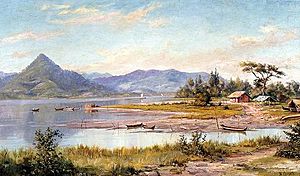Battle of São Vicente facts for kids
Quick facts for kids Battle of São Vicente |
|||||||
|---|---|---|---|---|---|---|---|
| Part of the Anglo–Spanish War | |||||||
 Painting of the Bay of São Vicente by Benedito Calixto |
|||||||
|
|||||||
| Belligerents | |||||||
| Commanders and leaders | |||||||
| Andrés de Equino | Edward Fenton | ||||||
| Strength | |||||||
| 3 galleons | 2 galleons 1 pinnace |
||||||
| Casualties and losses | |||||||
| 1 galleon sunk 1 galleon heavily damaged 36 killed and 100 wounded |
8 killed and 20 wounded | ||||||
The Battle of São Vicente was a sea fight that happened near São Vicente, in what was then Portuguese Brazil. It took place on February 3, 1583, during the Anglo–Spanish War.
Three English ships, led by Edward Fenton, were trying to trade in Brazil. They had failed to reach the Pacific Ocean earlier. A group of three Spanish ships, led by Commodore Andrés de Equino, found them. After a battle that happened mostly at night, the Spanish were defeated. One of their ships sank, and another was badly damaged. The English won, but Fenton could not trade as he hoped. He then sailed back to England.
Why the Battle Happened
In June 1582, an English group of ships set sail. Their goal was to explore and reach the South China Sea. Captain Edward Fenton led the group. His main ship was the large galleon Leicester. Other ships included the Edward Bonaventure, the small ship Elizabeth, and the Francis.
By December 1582, Fenton's plans changed. He decided to try sailing through the Straits of Magellan instead. On December 17, the English ships captured a Spanish ship. From its crew, they learned that Spain was fortifying the Strait of Magellan. This made Fenton worry about getting through.
So, Fenton changed course again. He decided to head north towards São Vicente. He hoped to trade with the people living there. A storm hit the ships, and the Francis was lost.
On January 30, 1583, Fenton's remaining ships reached São Vicente. They tried to trade with the Portuguese settlers in nearby Santos. But the settlers refused. Spain and Portugal were united at this time, and trading with the English was seen as an unfriendly act. Fenton then went to São Vicente itself, still hoping to trade.
The Battle Begins
On February 3, three Spanish galleons arrived in the bay of São Vicente. These were the San Juan Bautista, the Santa María de Begona, and the Concepción. They were part of a larger Spanish fleet. Commodore Andrés de Equino led them. They knew the English ships were there because they had met the Spanish ship the English had released earlier.
At 11 PM, under the moonlight, the Spanish ships prepared for battle. They sailed towards the three English ships. Many English sailors were still on shore and were surprised. But as the Spanish came closer, the English ships anchored themselves in shallow water near a sandbar.
Spanish fighting style at this time was to get close, grab onto the enemy ship, and then board it. English ships, however, preferred to use their cannons from a distance. They wanted to hit the enemy ships hard with cannon fire.
The English ship Leicester was the closest. It opened fire first. The Spanish ships were pushed back. They then tried to pass the Leicester and attack the Edward Bonaventure. But they were met with more heavy cannon fire from the English. The battle continued in the moonlight. The English ships held their ground, pushing back the Spanish attacks.
Around 4 AM, a rainstorm started. The Spanish stopped fighting to make repairs. The English did the same and gathered their sailors from shore.
After the Storm
Neither side knew how much damage they had caused until dawn. When the sun came up, the English could see the Spanish ship Begonia had sunk. Only its masts were visible in the shallow water.
At 10 AM, in daylight, Equino's two remaining galleons attacked again. But the English ships, still anchored, pushed them back once more.
Finally, the Spanish ships had many injured sailors and were running out of ammunition. They stopped fighting and sailed away, retreating down the Santos river. Fenton's ships were also low on ammunition, but they had won. They stayed in their position for a while.
What Happened Next
The battle was not very costly for the English. Only eight Englishmen were killed, and twenty were injured. Their ships had only moderate damage. An Indian person who visited the Leicester told Fenton that the Spanish had suffered much more. The Begonia had sunk, and 32 men died on it. The galleon Concepción was badly damaged. In total, nearly a hundred Spanish sailors were killed, and many more were injured.
Fenton's ships stayed at São Vicente for the rest of the day. He tried to trade again, but the Portuguese still refused. Fenton worried that more Spanish ships might arrive. So, he moved to Espirito Santo. News of the battle had reached there, but people still refused to trade.
Disappointed, Fenton realized he could not trade with the Portuguese here. His supplies were running low, and he had disagreements with his second-in-command, Hawkins. So, he decided to sail back to England. Some Spanish sources say that even though they lost, Equino's actions made Fenton decide to leave.
Warde's Edward Bonaventure got separated from the other ships on February 8. It sailed alone towards England. Fenton's ship reached Salvador to get more supplies before returning to England.


